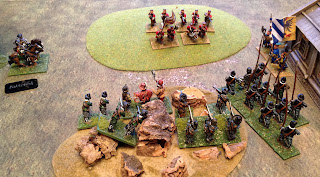The format is very similar to Lion Rampant so I will focus on the differences. You command a company rather than a retinue, but the scale is the same. These are often called skirmish rules, but they are really small battles with 40-60 figures a side. Officers have a background as well as traits and these can change as part of the campaign system. You start as an Ensign and can end up as a Colonel. Of course death and dishonour stalks any battlefield, so your officer can still be killed with a lucky blow, although there is now a recovery table after each game. Officers can still issue challenges to a duel - personally I am not convinced this is right at this scale of battle and period, but you can ignore it if you want.
Unit profiles are very similar with morale and stamina replacing courage and armour, albeit with similar functions. Unit types cover all the obvious western European renaissance types. Gallopers and Trotters for the horse, plus Dragoons, which can be adapted for light horse as they have the skirmish and evade moves and similar factors to the mounted yeoman in Lion Rampant. Foot units are pike and shot, not in mixed units as I read somewhere. Commanded Shot perform the skirmishing role and we have Forlorn Hope for more aggressive shot, with the ferocious rule and an upgrade to aggressive which cancels shooting, but makes them more effective in combat. There are Clansman units as well which are cheaper and slightly less effective, and Clubmen who are cheap rabble. Shot are encouraged to hold their fire with a first shot salvo benefit.
There are no obvious units to cover all the eastern European and further afield units. However, while the descriptors may seem a bit strange, I can see how you could fit them all in. My beloved Ottomans will still get on the table!
There is also a nice twist to spend the last couple of points by having agitators or priests to boost morale tests. Artillery is formed as regimental guns, appropriate for this scale of battle, but with the option of an upgrade to longer range field guns.
The order of action is largely unchanged with rally, wild charge and then normal activations. There is a new blunder type rule if you roll double 1 or double 6. The first leads to cowardly actions and the latter heroic ones. Shooting, combat and morale are similar, albeit with different weaponry.
Instead of scenarios, you get missions. These encourage specialist forces, like all cavalry and dragoons, to fight what look like some interesting games. Finally you get a few sample forces, just to start you off.
And so, onto the tabletop. I picked a Polish and a Swedish company. They fought a series of wars in the early 17th century, before the Thirty Years War kicked off. Some photos below. The Swede's succeeded in capturing the village, but not without serious loss. The game flowed well and was every bit as good as Lion Rampant. If you like those rules you will enjoy The Pikeman's Lament.
After first moves.
Pancerni v Dragoons
Finns storm into the Winged Hussars
Polish Haiduk foot
The Polish officer's last stand.





















